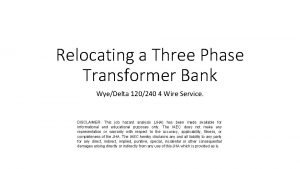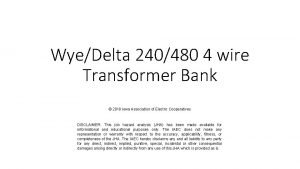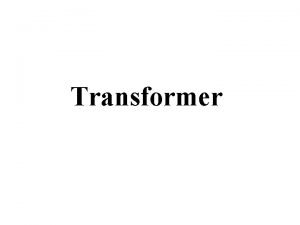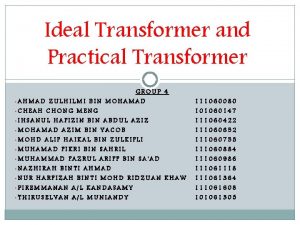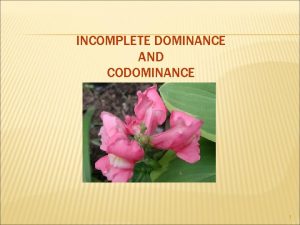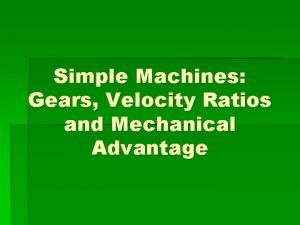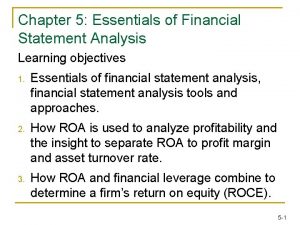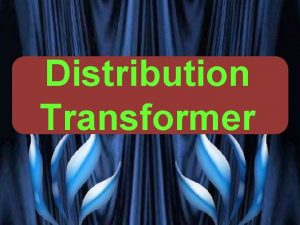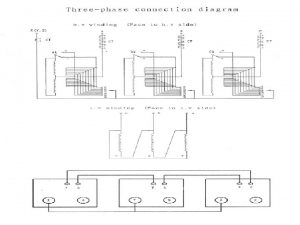3 Transformer Models Turns ratio 7200 240 30










- Slides: 10

3. Transformer Models. Φ Turns ratio 7200: 240 (30 : 1) (approx. same amount of copper in each winding) Rs j. Xs Rm j. Xm Ideal Transformer 7200: 240 V 7200 V Prof. Mack Grady, TAMU Relay Conference Tutorial Topic 3, March 31, 2015 240 V 1

3. Transformer Models, cont. Open Circuit Test Ioc Rs j. Xs Rm j. Xm 7200 V Φ + Voc - Ideal Transformer 7200: 240 V Open circuit test: Open circuit the 7200 V-side, and apply 240 V to the 240 V-side. The winding currents are small, so the series terms are negligible. Turns ratio 7200: 240 ~ Voc Rm || j. X m = ~ I oc Prof. Mack Grady, TAMU Relay Conference Tutorial, Topic 3, March 31, 2015 2

3. Transformer Models, cont. Short Circuit Test Isc + Vsc - Rs j. Xs Rm Short circuit test: Short circuit the 240 V-side, and raise the 7200 V-side voltage to a few percent of 7200, until rated current flows. There is almost no core flux so the magnetizing terms are negligible. j. Xm Ideal Transformer 7200: 240 V 7200 V 240 V Φ Turns ratio 7200: 240 Prof. Mack Grady, TAMU Relay Conference Tutorial, Topic 3, March 31, 2015 3

3. Transformer Models, cont. X / R Ratios for Three-Phase Transformers • 345 k. V to 138 k. V, X/R = 10 • Substation transformers (e. g. , 138 k. V to 25 k. V or 12. 5 k. V, X/R = 2, X = 12% • 25 k. V or 12. 5 k. V to 480 V, X/R = 1, X = 5% • 480 V class, X/R = 0. 1, X = 1. 5% to 4. 5% Rs j. Xs Ideal Rm j. Xm Transformer Prof. Mack Grady, TAMU Relay Conference Tutorial, Topic 3, March 31, 2015 4

3. Transformer Models, cont. 1. Given the standard percentage values below for a 125 k. VA transformer, determine the R’s and X’s in the diagram, in Ω. 2. If the R’s and X’s are moved to the 240 V side, compute the new Ω values. 3. If standard open circuit and short circuit tests are performed on this transformer, what will be the P’s and Q’s (Watts and VArs) measured in those tests? Single Phase Transformer. Percent values on transformer base. Winding 1 k. V = 7. 2, k. VA = 125 Load loss Xs No-load loss Rs Magnetizing current j. Xs Winding 2 k. V = 0. 24, k. VA = 125 Ideal Rm j. Xm %Imag = 0. 5 Transformer 7200: 240 V %Load loss = 0. 9 %No-load loss = 0. 2 7200 V 240 V %Xs = 2. 2 Prof. Mack Grady, TAMU Relay Conference Tutorial, Topic 3, March 31, 2015 5

3. Transformer Models, cont. EPRI Study, Distribution Feeder Loss Example • • Annual energy loss = 2. 40% Largest component is transformer no-load loss (45% of the 2. 40%) Secondary Lines 21% Annual Feeder Loss Components Transformer No. Load 45% Primary Lines 26% Transformer Load 8% Modern Distribution Transformer: • Load loss at rated load (I 2 R in conductors) = 0. 75% of rated transformer k. W. • No load loss at rated voltage (magnetizing, core steel) = 0. 2% of rated transformer k. W. • Magnetizing current = 0. 5% of rated transformer amperes 6

3. Transformer Models, cont. A three-phase transformer can be three separate single-phase transformers, or one large transformer with three sets of windings Wye-Equivalent One-Line Model N 1: N 2 A Rs j. Xs Rm j. Xm Ideal Transformer N 1 : N 2 N N 1: N 2 • Reflect to side 2 using individual transformer turns ratio N 1: N 2 Y-Y Standard 345/138 k. V autotransformers, GY-GY , have a tertiary 12. 5 k. V Δ winding to permit circulating 3 rd harmonic current Prof. Mack Grady, TAMU Relay Conference Tutorial, Topic 3, March 31, 2015 7

3. Transformer Models, cont. For Modeling a Delta-Delta Connection, Convert the Transformer to Equivalent Wye-Wye Wye-Equivalent One-Line Model A N 1: N 2 Rs 3 j. Xs 3 Rm 3 N N 1: N 2 j. Xm 3 Ideal Transformer N 1 3 : N 2 3 • Convert side 1 impedances from delta to equivalent wye • Then reflect to side 2 using individual transformer turns ratio N 1: N 2 Δ-Δ Prof. Mack Grady, TAMU Relay Conference Tutorial, Topic 3, March 31, 2015 8

3. Transformer Models, cont. For Modeling a Delta-Wye Connection, Convert the Transformer to Equivalent Wye-Wye Wye-Equivalent One-Line Model A N 1: N 2 Rs 3 j. Xs 3 N N 1: N 2 Rm 3 j. Xm 3 Ideal Transformer N 1 : N 2 3 • Convert side 1 impedances from delta to wye • Then reflect to side 2 using three-phase line-to-line turns ratio N 1: N 2 Δ-Y • Has 30° degree phase shift due to line-to-neutral to line-to-line relationship. ANSI standard requires the transformer to be labeled such that high-voltage side leads the low-voltage side by 30°. Prof. Mack Grady, TAMU Relay Conference Tutorial, Topic 3, March 31, 2015 9

3. Transformer Models, cont. For Modeling a Wye-Delta Connection, Convert the Transformer to Equivalent Wye-Wye Wye-Equivalent One-Line Model N 1: N 2 A Rs j. Xs Rm N N 1: N 2 j. Xm Ideal Transformer N 1 : N 2 3 • Reflect to side 2 using three-phase bank line-to-line turns ratio • Has 30° degree phase shift due to line-to-neutral to line-to-line relationship. ANSI standard requires the transformer to be labeled such that high-voltage side leads the low-voltage side by 30° N 1: N 2 Y-Δ Thus, for all configurations, equivalent wye-wye transformer ohms can be reflected from one side to the other using the three-phase bank line-to-line turns ratio Prof. Mack Grady, TAMU Relay Conference Tutorial, Topic 3, March 31, 2015 10
 7200/240
7200/240 120/240 transformer bank
120/240 transformer bank 240/480 transformer bank
240/480 transformer bank Primary and secondary winding of transformer
Primary and secondary winding of transformer Ideal and practical transformer
Ideal and practical transformer What is the difference between semi modals and modals?
What is the difference between semi modals and modals? Genotypic ratio of dihybrid cross
Genotypic ratio of dihybrid cross Velocity ratio vs gear ratio
Velocity ratio vs gear ratio Ukuran asosiasi epidemiologi
Ukuran asosiasi epidemiologi Acid test ratio and quick ratio
Acid test ratio and quick ratio Current ratio and quick ratio
Current ratio and quick ratio

